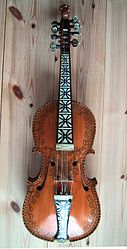
Back Hardangerviool Afrikaans Hardangerfele Danish Hardangerfiedel German Hardangeri viiul Estonian Hardangerviulu Finnish Violon Hardanger French Hardanger fidula Hungarian Hardingfele Italian ハーディングフェーレ Japanese Hardangerviool Dutch
 | |
| Classification | Bowed string instrument |
|---|---|
| Hornbostel–Sachs classification | 321.322-71 |
| Related instruments | |
A Hardanger fiddle (Norwegian: hardingfele) is a traditional stringed instrument considered to be the national instrument of Norway. In modern designs, this type of fiddle is very similar to the violin, though with eight or nine strings (rather than four as on a standard violin) and thinner wood. The earliest known example of the hardingfele is from 1651, made by Ole Jonsen Jaastad in Hardanger, Norway.[1] Originally, the instrument had a rounder, narrower body.[2] Around the year 1850, the modern layout with a body much like the violin became the norm.
The F-holes of the Hardanger fiddle are distinctive, oftentimes with a more "sunken" appearance, and generally straighter edges (unlike the frilly, swirly F-holes of a violin). Four of the strings are strung and played like a violin, while the rest, named understrings or sympathetic strings, resonate under the influence of the other four. These extra strings are tuned and secured with extra pegs at the top of the scroll, effectively doubling the length of a Hardingfele scroll when compared to a violin. The sympathetic strings, once fastened to their pegs, are funneled through a "hollow" constructed fingerboard, which is built differently than a violin's, being slightly higher and thicker to allow for these extra strings. The resonant strings lie on the center of the special bridge, attached to extra hooks (or fine-tuners) on the tailpiece. Carved out within the center of the bridge is a smaller secondary "bridge", or opening, designed specifically for these resonant strings to pass through. This is where the resonance is picked up and reverberated; as notes are played, the vibrations are sent through the bridge, where the sympathetics echo those notes.
The Hardingfele's bridge is unique compared to other bowed instruments. It is somewhat taller and wider, resulting in the strings being slightly lower and farther apart; this allows for the easy execution of double-stops (playing of two strings at once). A similar technique is seen in some American old-time and bluegrass fiddlers, who intentionally move their bridge back a few millimetres closer to the tailpiece, for better double-stops.
The hardingfele is used mainly in the southwest part of Norway, whereas the ordinary violin (called flatfele, 'flat fiddle', or vanlig fele, 'common fiddle') is found elsewhere. The hardingfele is used for dancing, accompanied by rhythmic loud foot stomping. It was also traditional for the fiddler to lead the bridal procession to the church.
The instrument is often highly decorated, with a carved animal (usually a dragon or the Lion of Norway) or a carved woman's head as part of the scroll at the top of the pegbox, extensive mother of pearl inlay on the tailpiece and fingerboard, and black ink decorations called 'rosing' on the body of the instrument. Sometimes pieces of bone are used to decorate the pegs and the edges of the instrument.